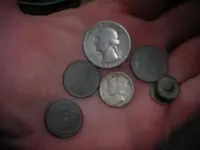The only ting wong is the pics are a little blurry

I use a Garrett 250 as a back up machine and as a 2nd machine for certian things and I'm here to tell ya - it will find things my $1200 machine doesn't even think of picking up on (especially tiny jewelry)
(tip)
it pays to have more than one detector because they all operate on diff frequencies which ultimately allows for you to find different things on the same site after having used one detector & cleaning the place out with it
detectors that operate on say 4.5 kHz to 17 kHz will be good at finding certain targets (and deeper) more so than at detector operating on say 14 kHz to 50 kHz, and vise/versa.
this also applies in other aspects like a detector that operates on a range from 3 kHz to 50 kHz or like a minelab that has FBS tech and operates on a wider range of 1.5 kHz to 100 kHz.
Futher more, frequencies in a metal detector are referred to in kHz (kilo hertz) which is the number of times a signal is transmitted into the ground as received back per second. The lower the detector's frequency, the deeper it will penetrate. However, its sensitivity to smaller targets may be reduced. On the other hand, the higher the detector's frequency, the higher its sensitivity to even the smallest targets, but it may not penetrate as deeply.
Generally, gold detectors operate at a higher frequency for locating small gold nuggets. Coin, relic and treasure hunting detectors operate at lower frequencies for greater depth penetration.







 Very Nice Dig's....Thank's....
Very Nice Dig's....Thank's....



 Or, I can mail some of 'em to ya, if ya want 'em for a CW case.
Or, I can mail some of 'em to ya, if ya want 'em for a CW case. 